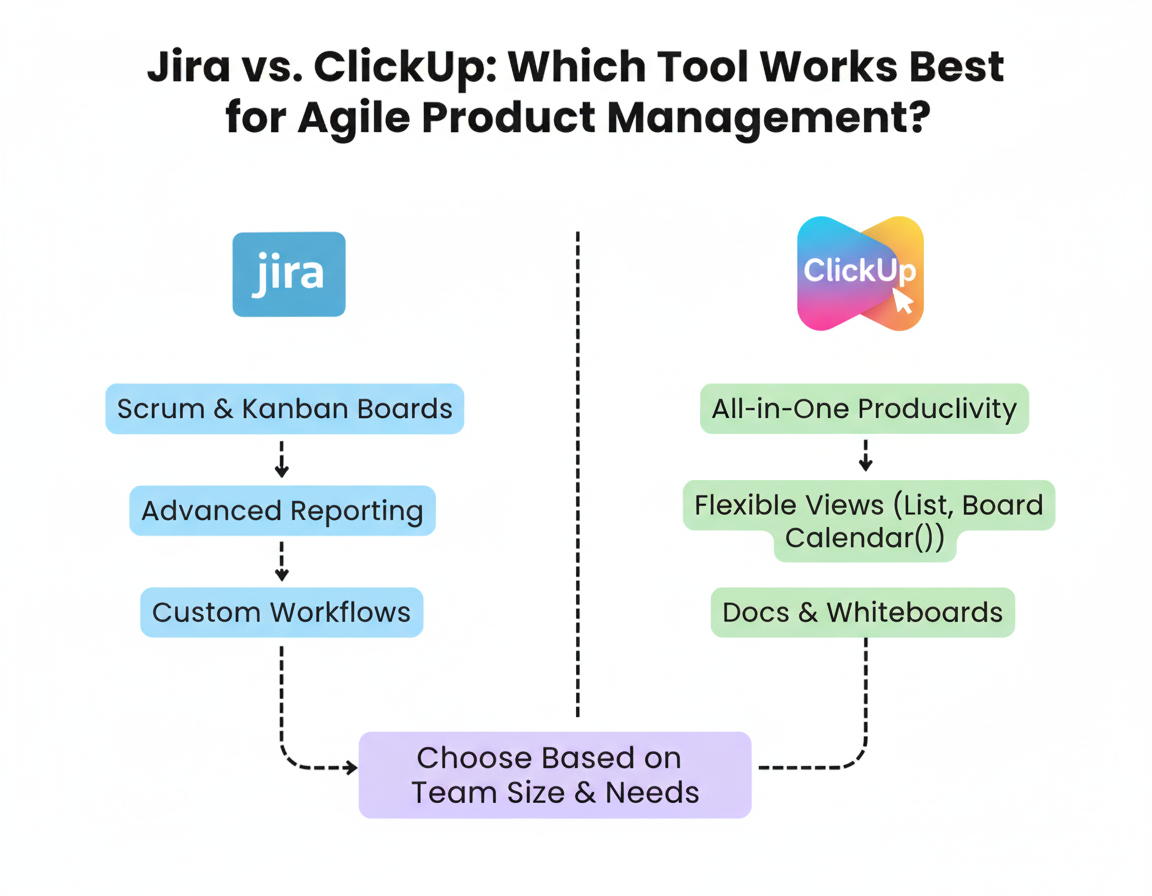
Jira vs. ClickUp: Best Agile Product Management Tool 2025
Headway: Comparing Jira and ClickUp for Agile Product Management
Product management demands tools that support clarity, speed, and adaptability. Teams building software, SaaS, or digital products need platforms where planning, tracking, and collaboration work smoothly. Jira and ClickUp are among the most popular options. Each offers strengths and trade-offs when applied to agile workflows, backlogs, roadmaps, sprint planning, and feedback loops. At Product Siddha we often help teams make the right choice for their product lifecycle, aligning tool features with methods and process needs.
Core Features and Differences
Below are core dimensions that matter for agile product management, and how Jira and ClickUp compare.
| Feature | Jira | ClickUp |
|---|---|---|
| Backlog & Sprint Planning | Built for software engineering teams. Strong support for Scrum boards, Kanban, epics, stories, tasks. Deep integration with code management. | Flexible views (List, Board, Gantt, Calendar). Easier to set up for small or mixed teams. Can mimic sprints with custom statuses or “Sprint Box” templates. |
| Roadmapping & Prioritisation | Jira Product Discovery helps capture ideas, prioritise features, and create roadmaps tied to delivery work. | ClickUp provides visual roadmap templates, product vision boards, and goal alignment dashboards. Prioritisation via custom fields, priorities, and dependencies. (ClickUp) |
| Documentation & Collaboration | Jira is part of a suite that usually includes Confluence (in many setups) for docs; collaboration is often external or via issue comments. Strong with engineering‐oriented tasks. | ClickUp includes Docs, Whiteboards, integrated discussion threads, comments, and attachments. Collaboration tends to be more visible across teams beyond engineering. |
| Flexibility vs Rigidity | Very strong support for workflows, permissions, issue types, and custom fields. But this comes with a steeper learning curve. Configuration overhead can slow teams without dedicated admins or discipline. | More out-of-the-box flexibility. Easier to get started for non-technical or cross-functional teams. But very complex use cases may hit limits or need workarounds. |
| Reporting, Metrics & Analytics | Rich reporting: burn-down charts, cumulative flow diagrams, velocity tracking. Good for product managers concerned about productivity, forecasting, and technical debt. | Dashboards are strong; Widgets and custom metrics help. But for deep engineering insight (e.g., commit-to-deploy, CI/CD integration), sometimes we need additional tools. |
Case Study: Product Siddha’s Approach
At Product Siddha, we often advise early-stage startups or teams scaling up. In one recent project, we helped a mid-sized SaaS business select between Jira and ClickUp for their product management process. They had been using ClickUp for years for task tracking and general collaboration, but found difficulties when scaling agile practices.
Background
- The team had about 25 people, split between engineering, design, product, and support.
- They used ClickUp for many tasks, but sprint planning, backlog grooming, and roadmaps were inconsistent. Prioritisation often depended on whoever shouted loudest.
- They lacked a stable engineering metrics system and found that “tasks stuck” or dependencies were missed.
What We Did
- We mapped their product management process: how features are requested, how priorities are determined, how deliveries happen, and how feedback loops are managed.
- We defined what mattered: traceability, transparency, reporting, ability to connect feature requests to outcomes.
- We trialed both tools: configured ClickUp with stricter workflows, custom statuses, dependencies, and Gantt or roadmap views; and set up Jira for their backlog, epics, sprint boards, and integrated issue types.
Outcome
- They found that ClickUp worked well for planning and early concept phases. Product managers liked its ease of use, documentation, and collaborative whiteboarding.
- But as teams grew, engineering felt that Jira offered more discipline: clearer epics, better handling of technical debt, better visibility for blockers, tighter backlog grooming.
- Eventually, the decision was to adopt hybrid use: Use ClickUp for documentation, planning, and cross-team collaboration (design, product, support) and use Jira for engineering execution, sprint tracking, and issue management.
When Each Tool Works Best
From what Product Siddha and others have seen, here are good fits:
- Choose Jira when your team needs strong structure around engineering: many dependencies, code integration, a need for detailed tracking of defects, technical backlog, and release management.
- Choose ClickUp when your team values flexibility: collaboration across functions (design/product/support), lighter-weight workflows, faster ramp-up, and fewer dedicated admin overheads.
- A Hybrid Approach often gives balance: one tool optimized for execution, another for broad visibility and product strategy. But hybrid demands discipline: keeping data in sync, ensuring people know where to look for what.
Product Management Best Practices Regardless of Tool
Whatever tool you pick, certain practices matter for product management to succeed:
- Define your backlog grooming process clearly. Regular reviews, definition of ready, prioritisation criteria.
- Ensure stakeholder alignment. Roadmaps must reflect business goals, not just engineering capacity. Communication matters.
- Use metrics that feed product decisions: lead time, cycle time, velocity, feature usage, and customer feedback.
- Keep feedback loops tight: after launches, gather data, iterate. Connect what customers say with what the backlog holds.
- Training and adoption: A tool is only as good as how people use it. Provide clear guidelines, templates, and governance (who updates what, who owns backlog, who marks what done).
Considerations and Trade-Offs
- Cost: Jira often has licensing costs and sometimes adds-ons (workflow apps, additional storage); ClickUp may scale in cost depending on plan, seats, and feature needs.
- Learning curve: Jira’s flexibility means setup can be complex; teams without prior product management discipline may struggle. ClickUp is more forgiving, more adaptable, but it might lack some depth for mature engineering organisations.
- Integration with existing tools: If you are already using Confluence, Bitbucket, GitHub, or have CI/CD pipelines, Jira may integrate more naturally. If tools are diverse, ClickUp’s integrations are broad and useful.
- Governance and consistency: With flexibility comes risk of chaos. Unclear workflows, differing statuses, and inconsistent definitions of Done can create confusion, whatever tool you use.
Closing Thoughts
Choosing between Jira and ClickUp for agile product management depends on what your product team values and where it is in its growth. At Product Siddha, we believe the right tool is the one that matches process maturity, team size, and the product’s complexity.
If your team is small or in early stages, or emphasizes cross-functional work, ClickUp may offer speed, a gentler learning curve, and visible collaboration. If your team has heavier technical demands, many dependencies, or needs tight release discipline and traceability, Jira offers features and control designed for that world.
In many cases, combining parts of both – ClickUp for strategy, planning, cross-team visibility, and Jira for engineering execution – gives good results. The key is clarity in who owns what, what workflows look like, and good discipline in the process. Doing that avoids wasted time, miscommunication, and lost product momentum.
